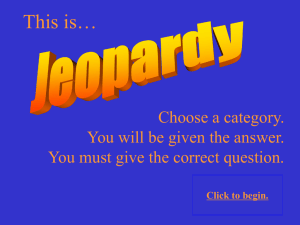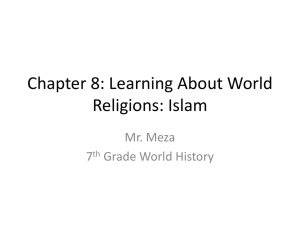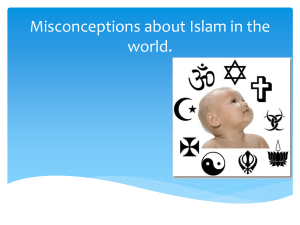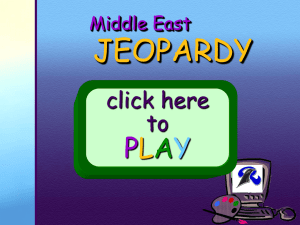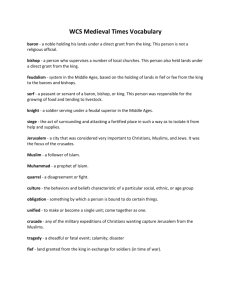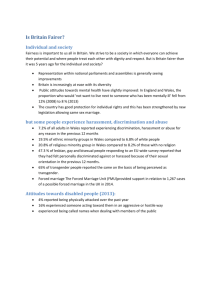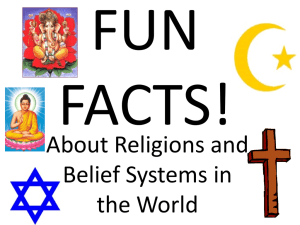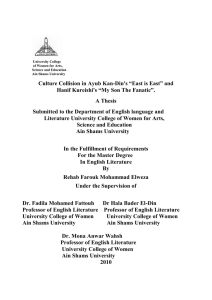Post-Colonialism and migration: East is East
advertisement
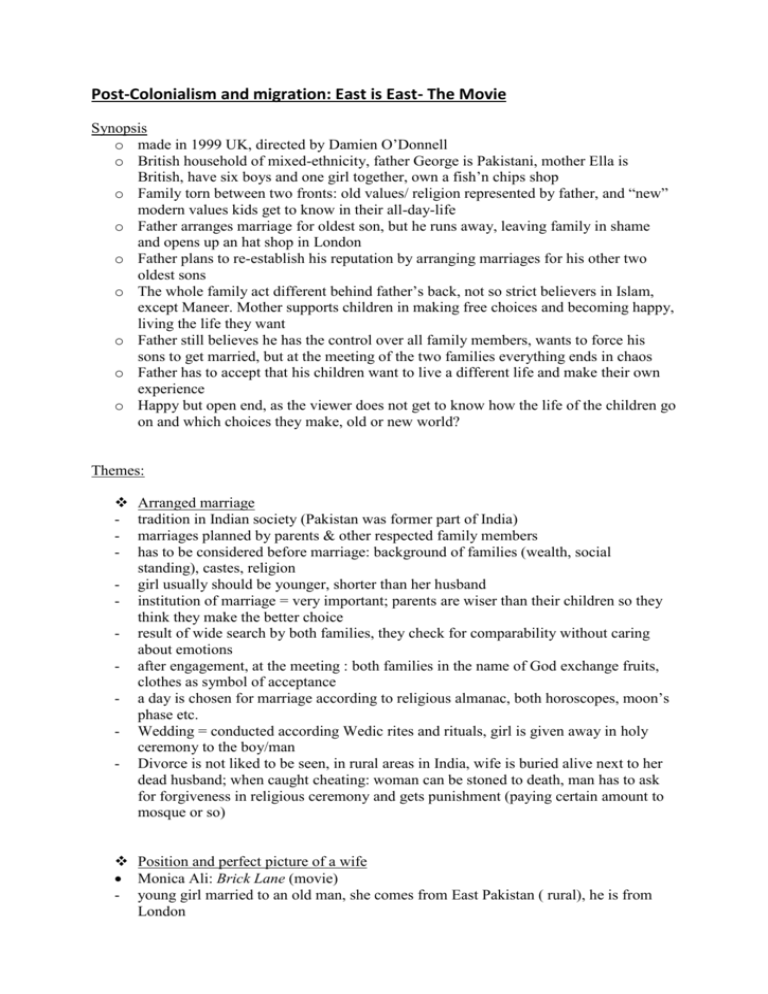
Post-Colonialism and migration: East is East- The Movie Synopsis o made in 1999 UK, directed by Damien O’Donnell o British household of mixed-ethnicity, father George is Pakistani, mother Ella is British, have six boys and one girl together, own a fish’n chips shop o Family torn between two fronts: old values/ religion represented by father, and “new” modern values kids get to know in their all-day-life o Father arranges marriage for oldest son, but he runs away, leaving family in shame and opens up an hat shop in London o Father plans to re-establish his reputation by arranging marriages for his other two oldest sons o The whole family act different behind father’s back, not so strict believers in Islam, except Maneer. Mother supports children in making free choices and becoming happy, living the life they want o Father still believes he has the control over all family members, wants to force his sons to get married, but at the meeting of the two families everything ends in chaos o Father has to accept that his children want to live a different life and make their own experience o Happy but open end, as the viewer does not get to know how the life of the children go on and which choices they make, old or new world? Themes: - Arranged marriage tradition in Indian society (Pakistan was former part of India) marriages planned by parents & other respected family members has to be considered before marriage: background of families (wealth, social standing), castes, religion girl usually should be younger, shorter than her husband institution of marriage = very important; parents are wiser than their children so they think they make the better choice result of wide search by both families, they check for comparability without caring about emotions after engagement, at the meeting : both families in the name of God exchange fruits, clothes as symbol of acceptance a day is chosen for marriage according to religious almanac, both horoscopes, moon’s phase etc. Wedding = conducted according Wedic rites and rituals, girl is given away in holy ceremony to the boy/man Divorce is not liked to be seen, in rural areas in India, wife is buried alive next to her dead husband; when caught cheating: woman can be stoned to death, man has to ask for forgiveness in religious ceremony and gets punishment (paying certain amount to mosque or so) Position and perfect picture of a wife Monica Ali: Brick Lane (movie) - young girl married to an old man, she comes from East Pakistan ( rural), he is from London - he expected her to be more beautiful, had a better education, but she is better than nothing to him - Nazneen is disappointed, maybe they could have fallen in love, because he was gentle and caring example of a convenience marriage without any emotions, she feels betrayed, rejected; he is satisfied half, because he at least has something(!) = unfulfilled expectations - The Gift by Chitra Banerjee Divakaruni Poem, shows what is expected from Asian wives in general A good woman: should be gentle, caring, respectful to her husband, serving him; preserves the honour of her own family, has to be quiet, regard her husband as a god, never leaves him - Speaker of the poem feels pressured, still it is her duty to fulfil these expectations, acts like robot, cannot change the situations nor improve it young women accept their task to serve a man, because they represent their family in that way, have to respect it, feel empty and sorrow; others were born to serve like preserving the honour of their family, are religious and believe therefore in this dominance-system - - - Pakistani husband / British wife: rules, different views East is East shows different way of relationship between Pakistani and British people George comes from Pakistan, left his 1st wife there, married British Ella in England George tries to live strictly according to the guidelines of Islam (going to mosque, praying, eating no pork, drinking no alcohol), but Ella sometimes does not support him She knew that she had to accept her subordinate position when marrying George (accept the concision of the boys, learning the language Urdu, that the girl has to mantle herself/ hair etc), but George goes too far with the arranged marriages She has a different picture of a family in mind: for her, her children should become happy, do what makes them happy; George wants them to become respectful and believing married Muslims 2nd Generation and old traditions: both sides of the medal Personal Identity: self-awareness sets us human beings apart from animals - Factors shaping an individual’s personality: some of these are hereditary, other influences come from environment - Everyone’s personality = unique; aspects of identity are racial, ethnic, national, regional and class identities - Religious identity determines our moral code in life - Gender identity (how we feel towards our identity as a man or woman) and sexual identity (who we are interested in sexually) - Doubts about our identity = identity crisis with self-doubts (very destructive, prevent us from realizing our full - Success in achieving our goals has lot to do with how we perceive ourselves - Identity is not constant (many aspects change through lifetime) & no can be reduced to just one trait or feature many factors have to be considered when looking at different cultures and generations Family Khan and their conflicts Pakistani culture and Muslim religion - very important for him to go to mosque, follow the religious guidelines - marries his sons to keep family tradition and a good reputation - Doesn’t want any family members from Pakistan to come over to England - She is not acceptable as Pakistani wife, freedom-loving - hides from mosquevan, religion is not important for him - is circumcised, should behave respectful towards father - feels too restricted by religion, wants to free herself - likes the culture, but wants to make free, own choices - riots against religion and strict father, wants to make own choices in life The Khans -doesn’t care about religion Saleem - “Ghandi”, strict believer Maneer - respects traditions/ father, but family stands above everything Abdul George English people and culture - - Ella - - Sajid - - Meenah - - Tariq laughs about English culture, thinks they are obscene G. isn’t accepted, Fish’n Chips Shop keeper wants the people to think she’s a polite / respectful wife shouldn’t have married a foreigner feels integrated in English society, his opinion counts (e.g. Earnest) still others don’t accept him, he’s pushed around plays soccer, eats pork, wears school uniform, integrates in society likes her personal freedom - integrated in society, has a British girl - has a 2nd different name to integrate in society, is prepared to give up his origin to integrate in society - studies art, instead of engineering, free artist - wants his family to be happy, respects George, but after beating stops respecting - works in British job, is respected by everyone => Family Khan represents typical problems a mixed family has in certain generations “My Son the Fanatic” by Hanif Kureishi Aspect/Topics Parvez Religion (Islam) Bad memories, avoids all religions The West (England) Gives more opportunities, integrates in Western world “philosophy of life” Enjoy life without hurting others, beauty of living (one life to live), appreciate what you have Way of life Taxi driver, hides from wife, runs away Didn’t learn a lot in Punjab, wants to give his son possibility to have a better education Parvez had Education Ali Strong believer, very engaged in religious matters, no exceptions, lives according to 5 pillars of Islam Western lifestyle = full of sins, Western people hate people like Ali “For us the reward will be in paradise”, law of Islam should rule the world, enjoyment is a bottom less pit Praying 5 times a day, sticking to Koran College, most subjects A Possible conflicts in multicultural families in Britain 1st generation (parents) 2nd generation (children) Khan family - G. Tries to hold onto old traditions/ values - Partly integrated - - try to integrate, still have to show respect to 1st generation like the Western world with it’s free choices/ possibilities clash of cultures within families communication problems reversal roles religion/ tradition VS. Integration / Western values problems to find identity Integration (choice) mutual process Assimilation (force) one-sided “My Son the fanatic” - integrated, assimilated - respects his son’s decisions, wants to make him happy - narrow-minded, radical, fundamentalist, strict/ traditional believer - no integration - Character Constellation in “East is East” Married, 2nd wife, love but struggle for dominance in family friends Asks for support Religious, strict dominant man wants arranged marriages for George’s sons, teaches children the religion Gay, has own hat shop, dead for his father (flew from arranged marriage) Development from shy to confident Honest worker, family guy, respectful to father’s wishes fight Beats him up Rebel, libertine Stereotypical British woman, helps Ella a lot, cares about kids friends Loves all her children, wants the best for them Hopes he’ll be successful (engineer), but in fact studies art, father shouldn’t know Very religious, torn btw. modern/ traditional world Make out Only daughter, sometimes boyish attitude In love with her Tease each other all the time She thinks he is ugly Loves him in a very romantic way, wants to marry him, he refuses Best friends Youngest of the family, hides beneath his parker, pushed around by everyone - John Enoch Powell Grandpa Moorhouse makes commercial for this politician British politician, conservative Has strong views according to race, national identity, immigration Warned audience about uncontrolled immigration: River of Blood-Speech (too many immigrants, wants them to be send back) Accused of xenophobia, removed from shadow cabinet 74% of all Britains agreed to him was voted into the list of 100 greatest Britains of all time in 2002 Islam in Britain - known in Britain since Middle Ages, 1st large group came 300 years ago (sailors recruited in India to work for East India Company), port towns - next wave: opening of Sue Canal in 1869: increase of trade demand for men to work in ports, ships - many immigrants in 1950s /1960s came from India, Pakistan in search of better material life, lot of them worked in steel/ textiles industries Yorkshire, Lancaster - many planned to bring their families to Britain, others hoped to save money to buy land in Pakistan and return to families - in 1990s increase in enforced arranged marriages, Pakistani men using their wife’s status to gain entry to Britain increased from 1.740 in 1995 to 3.510 in 1997 - today 1.8million Muslims live in Britain, at least 50% born in UK, Islam: British 2nd most popular religion, over 600.000 Britain’s Muslims are active in their faith - most British Muslims belong to Sunni tradition of Islam, over 600 mosques in UK, 60 Muslims school - 2001: race riots erupted in “mill and mosque” towns of Oldham, Bradford, Burnley; after Islamist attacks on 11th September 2001 more than 300 assaults on Muslims in Britain mainly on women - 2002: poll showed 69% of British Muslims felt strong sense of exclusion, two thirds say relations between Muslims and non-Muslims have deteriorated since 9/11 - Poll shows that there is a strong desire to integrate into British Society, also shows significant generation gap: 41% under 34 who were born in UK said they defined themselves first and foremost as Muslim - More likely to say that their community was too integrated, Islam particularly appeals to the young - Integration of 2nd and 3rd generation immigrants will be major challenge to multicultural Britain Islam: a) Sunnite: descendants of all four caliphs can be spiritual leaders of the Sunnites b) Shi’ite: only descendants of Ali (Muhammad’s son-in-law) can be spiritual leaders of the Shi’ite Immigration to Britain Young Asians in Britain today - Experience the same types of hostility and discrimination as their parents, but they do not accept discrimination as inevitable - Face two worlds: Asian world at home, other world of school, community, work - The social and psychological gab between them and their parents widens - Young Asians; no longer language difficulties, more chance in future to create friendship across ethnic boundaries - Asian parents and their children have quite different views on leisure, freedom as well as clothes - Fathers are stricter and disagree, Asian parents feel they have protect their children, girls in particular Young Asians adopt new culture which is a synthesis of the “old” and the “new”
